Digital Poster
Imaging Affective Disorders
ISMRM & ISMRT Annual Meeting & Exhibition • 03-08 June 2023 • Toronto, ON, Canada

| Computer # | |||
|---|---|---|---|
4927.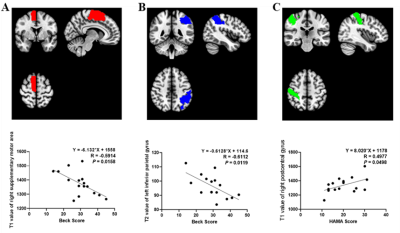 |
161 |
Quantification of gray matter abnormalities in drug‑naïve major
depressive disorders by synthetic MRI
Junyan Wen1,
Shanshan Yang1,
Xuecong Lin1,
Wei Cui2,
Long Qian2,
Zhimin Chen1,
Liaoming Gao1,
Qian Gao3,
Weikang Huang 4,
Dongliang Cheng5,
and Ge Wen1
1Medical Imaging Department, Nanfang Hospital, Guangzhou, China, 2MR Research, GE Healthcare, Beijing, China, Beijing, China, 3Department of Radiology, the First Affiliated Hospital of Kunming Medical University, Kunming, China, 4Department of Radiology, Zengcheng Branch of Nanfang Hospital, Guangzhou, China, 5Department of Radiology, First People's Hospital of Foshan, Foshan, China Keywords: Psychiatric Disorders, Brain, Major depressive disorder Major depressive disorder (MDD) is a common mental illness. Herein, we explored the differences in the whole-brain T1 and T2 relaxation times between drug-naïve major depressive disorder patients and healthy controls by synthetic MRI (SyMRI). The results showed altered T1 and T2 values in specific regions of the gray matter in MDD patients, which may be associated with alterations in the brain gray matter microstructure, such as excessive iron deposition. Thus, these quantitative variables may be promising imaging markers for further exploring the pathophysiological mechanisms of depression. |
|
4928.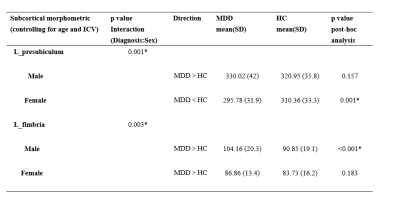 |
162 |
Sex Difference of Hippocampal Subfields in First-episode
Drug-naive Patients with Major Depressive Disorder
Mengyue Tang1,
Lianqing Zhang1,
Zilin Zhou1,
Lingxiao Cao1,
Yingxue Gao2,
Hailong Li2,
Xinyue Hu1,
Kaili Liang2,
Weijie Bao2,
Yingying Wang1,
Weihong Kuang2,
Qiyong Gong1,
and Xiaoqi Huang2
1Department of Radiology, Huaxi MR Research Center (HMRRC), Functional and Molecular Imaging Key Laboratory of Sichuan Province, Department of Radiology, West China Hospital of Sichuan University, Chengdu, China., Chengdu, China, 2Huaxi MR Research Center (HMRRC), Functional and Molecular Imaging Key Laboratory of Sichuan Province, Department of Radiology, West China Hospital of Sichuan University, Chengdu, China., Chengdu, China Keywords: Psychiatric Disorders, Brain We investigated hippocampal subfields volumes in a relatively large sample of first-episode drug-naive MDD and explored sex-related effects. We used Freesurfer software to segment the hippocampus with longitudinal axis and transverse axis automatically. We found there were different alterations of hippocampus along different axis. The sex-independent decreased volume of hippocampal and its subregions along the longitudinal, while the sex specific alteration only detected in the subfields along the transverse axis. These current findings may interpretate the hippocampus appears to have functional segregation along the different axis, which may contribute to developing new diagnostic and mechanism of sex difference for MDD. |
|
4929.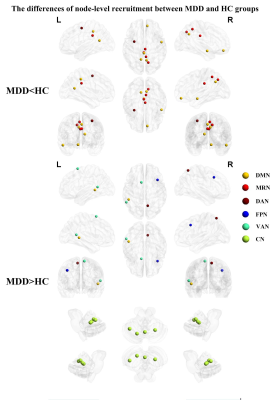 |
163 |
Analysis of Dynamic Network Reconfiguration in First-Episode,
Drug-Naive Patients with Major Depressive Disorder Based
Multilayer Network
Yingying Wang1,
Mengyue Tang1,
Zilin Zhou1,
Yingxue Gao1,
Linxiao Cao1,
Hailong Li1,
Xinyue Hu1,
Weijie Bao1,
Kaili Liang1,
Lianqing Zhang1,
Weihong Kuang2,
Qiyong Gong1,
and Xiaoqi Huang1
1Huaxi MR Research Center (HMRRC), Functional and Molecular Imaging Key Laboratory of Sichuan Province, Department of Radiology, West China Hospital of Sichuan University, Chengdu, China., Chengdu, China, 2Department of Psychiatry, West China Hospital of Sichuan University, Chengdu, China Keywords: Psychiatric Disorders, Neuro We collected resting-state fMRI data from 115 patients with major depressive disorder (MDD) and 120 healthy controls (HC). The GenLouvain community detection algorithm was performed to identify the temporal evolution of community in the multilayer network. Recruitment and integration coefficients were calculated according to the module allegiance matrix to quantify the dynamic characteristic of a node within each of the networks. We found aberrant recruitment and integration coefficients in MDD patients and their significant correlations with clinical scores, and such abnormally dynamic network reconfiguration provides a new perspective to explain the neurobiological characteristics of MDD patients. |
|
4930.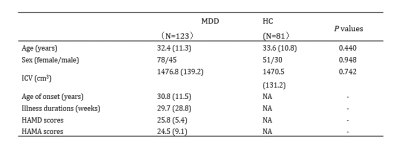 |
164 |
Alterations of the structural covariance network in the thalamic
subnuclei of non-comorbid treatment-naïve patients with major
depressive disorder
xinyue Hu1,
lianqing Zhang1,
hailong Li1,
Mengyue Tang1,
Hui Qiu1,
Yongbo Hu1,
Yingxue Gao1,
Weihong Kuang2,
Qiyong Gong1,
and Xiaoqi Huang1
1Huaxi MR Research Center (HMRRC), Department of Radiology, West China Hospital, Sichuan University, Chengdu, China, 2Department of Psychiatry, West China Hospital of Sichuan University, Chengdu, China Keywords: Psychiatric Disorders, Gray Matter The thalamus is one of the key structures involved in the pathophysiology of major depressive disorder (MDD). Most previous neuroimaging studies on MDD measured the volume of thalamus as a whole, however, the thalamus consists of multiple subnucleus with distinct function and connectivity. Recent advances in structural MRI segmentation techniques have enabled the measurement of the volumes of thalamic subnucleus with a robust, automatic approach using a Bayesian inference-based atlas-building algorithm. Using this algorithm, we aimed to investigate the alternations in volume and structural covariance networks in thalamic subnucleus in a relatively large sample of non-comorbid treatment-naïve patients with MDD. |
|
4931.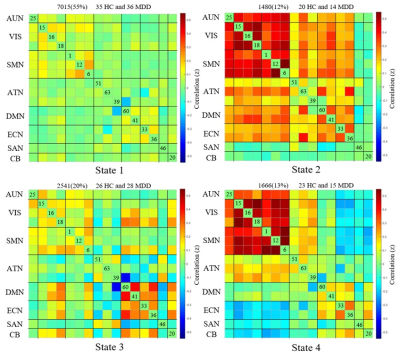 |
165 |
Abnormal dynamic function connectivity pattern in first-episode,
drug-naïve adult patients with major depressive disorder
Tao Chen1,
Zhongyi He2,
Qinger Guo1,
Jinfeng Duan3,
Yong Zhang4,
Min Wang2,
and Hong Yang1
1Radiology, First Affiliated Hospital, School of Medicine, Zhejiang University, Hangzhou, China, 2College of Biomedical Engineering and Instrument Science, Zhejiang University, Hangzhou, China, 3Psychiatry, First Affiliated Hospital, School of Medicine, Zhejiang University, Hangzhou, China, 4GE Healthcare, Shanghai, China Keywords: Psychiatric Disorders, fMRI (resting state) Objective: To explore the specific FC change patterns of MDD by combining sFC and dFC. Methods: 37 MDD and 36 matched HCs were included in this study. The differences of sFC and dFC between two groups were compared. Results: Compared to HCs, patients showed less time in the anti-correlated state between higher-order and lower-order networks and longer dwell time in the whole-brain weakly connected state. The mean dwell time of state 4 was negative correlation with the behavioral scale score in patients. Conclusions: These disrupted dFC patterns provide new clues to understanding the neuropathology of state-dependence in MDD. |
|
4932.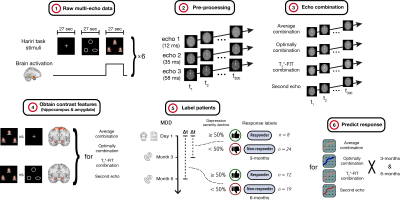 |
166 |
Evaluation of different multi-echo combinations on objective
depression prognosis in an emotional face-matching task
Jesper Pilmeyer1,2,
Rolf Lamerichs1,3,
Faroeq Rahmat Ramsaransing1,2,4,
Marcel Breeuwer1,5,6,
and Svitlana Zinger1,2
1Electrical Engineering, Eindhoven University of Technology, Eindhoven, Netherlands, 2Department of Research and Development, Epilepsy Centre Kempenhaeghe, Heeze, Netherlands, 3Philips Research, Eindhoven, Netherlands, 4Department of Psychiatry, Amsterdam University Medical Center, Amsterdam, Netherlands, 5Department of Biomedical Engineering, Eindhoven University of Technology, Eindhoven, Netherlands, 6Philips Healthcare, Best, Netherlands Keywords: Psychiatric Disorders, fMRI (task based), Multi-echo imaging Objective prognosis of major depressive disorder (MDD) based on functional MRI (fMRI) biomarkers remains problematic due an abundance of physiological and motion confounders. Multi-echo imaging enhances the BOLD sensitivity while reducing signal loss. Here, we evaluate the effect of different multi-echo combinations on MDD symptom improvement prediction in an emotional face-matching fMRI task. We demonstrate improved signal quality and activation contrast for multi-echo combinations in the amygdala and hippocampus and predict 3-months and 6-months MDD symptom improvement with 91% and 87% accuracy, respectively. These results highlight the benefits of novel multi-echo acquisitions for prognosis in psychiatric disorders. |
|
4933.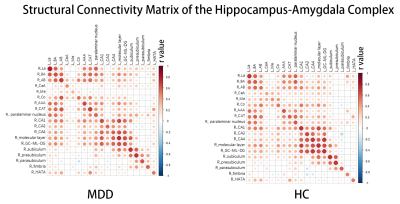 |
167 |
The Hippocampus-Amygdala Complex Show Altered Structural
Covariance Properties in Never-treated Patients with
First-Episode Depression
Lianqing Zhang1,
Xinyue Hu1,
Mengyue Tang1,
Hui Qiu1,
Yongbo Hu1,
Yingxue Gao1,
Hailong Li1,
Weihong Kuang2,
and Xiaoqi Huang1
1Huaxi MR Research Center (HMRRC), Functional and molecular imaging Key Laboratory of Sichuan Province, Department of Radiology, West China Hospital, Sichuan University, Chengdu 610041, China, Chengdu, China, 2Department of Psychiatry, West China Hospital of Sichuan University, Chengdu, PR ChinaMRRC), Functional and molecular imaging Key Laboratory of Sichuan Province, Department of Radiology, West China Hospital, Sichuan University, Chengdu 610041, China, Chengdu, China Keywords: Psychiatric Disorders, Neuroscience, hippocampus, amygdala The hippocampus and amygdala are densely interconnected structures that work together in multiple affective and cognitive processes that are important to the etiology of major depressive disorder. By constructing a network based on the volumetric covariation among subfields/subregions within the hippocampus-amygdala complex, we found the topologic properties within localized network of the hippocampus-amygdala complex were disrupted in never-treated patients with first-episode depression. The current study provided the first evidence of atypical structural covariance network within the hippocampus-amygdala complex in patients with early stage of MDD, which could be a potential biomarker in the future psychoradiological practices. |
|
4934.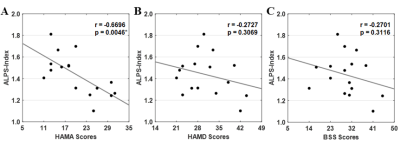 |
168 |
Glymphatic system dysfunction in patients with major depressive
disorder
Shanshan Yang1,
Xuecong Lin1,
Junyan Wen1,
Wei Cui2,
Long Qian2,
Weiwei Cui1,
Ziqi Wu1,
Peiqian Hu3,
Liyang Yang4,
and Ge Wen1
1Medical Imaging Department, Nanfang Hospital, Guangzhou, China, 2MR Research, GE Healthcare, Beijing, China, Beijing, China, 3Department of Radiology, Zhujiang Hospital of Southern Medical University, Guangzhou, China, 4Department of Radiology, Zengcheng Branch of Nanfang Hospital, Guangzhou, China Keywords: Psychiatric Disorders, Brain, Major depressive disorder Major depressive disorder (MDD) is a severe mental sickness. Yet, its neural mechanisms remain unclear. The present study aimed to analyze the different degrees of glymphatic system activity between patients with MDD and healthy controls using diffusion tension imaging (DTI) along the perivascular space (DTI-ALPS). The results showed that the patients with MDD had glymphatic system dysfunction, which increases anxiety. Thus, the ALPS index is expected to be a biomarker for monitoring changes in glymphatic system function in MDD patients. |
|
4935. |
169 |
Left DLPFC - left ACC resting state functional connectivity
association with response to rTMS therapy of major depressive
disorder
Pallab Bhattacharyya1,
Amit Anand2,
Xuemei Huang1,
Mark Lowe1,
and Murat Altinay1
1Cleveland Clinic Foundation, CLEVELAND, OH, United States, 2Brigham and Women's Hospital, Boston, MA, United States Keywords: Psychiatric Disorders, Psychiatric Disorders High frequency repetitive transcranial magnetic stimulation (rTMS) targeted at left dorsolateral prefrontal cortex (lDLPFC) is an increasingly popular therapy of patients with major depressive disorder, who are inadequately responsive to medication treatment. There is evidence of resting state functional connectivity (fcMRI) between lDLPFC and left anterior cingulate cortex (lACC) playing a role in rTMS efficacy. We performed a longitudinal study by scanning patients before and after 6-week long 10-Hz rTMS therapy. Patients with lower resting state low frequency blood oxygen level dependent fluctuation correlation and anticorrelation between lDLPFC and lACC responded better to rTMS therapy. |
|
4936.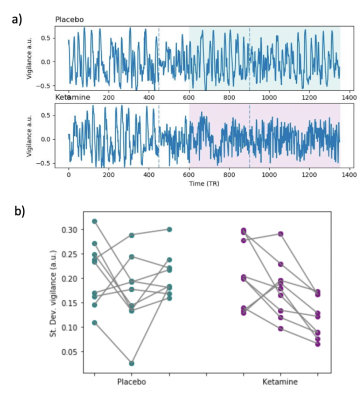 |
170 |
Effect of acute ketamine on vigilance measured by multi-echo
fMRI in treatment resistant major depression
Jennifer Evans1 and
Carlos Zarate1
1NIH, Bethesda, MD, United States Keywords: Psychiatric Disorders, Drugs, major depression, ketamine We investigate vigilance changes during intravenous ketamine administration in patients with treatment resistant major depression using an fMRI arousal template. There is a significant decrease in the average vigilance index after ketamine infusion as compared to placebo. The fMRI based vigilance index shows promise in detecting the rapid onset of ketamine administration effects. |
|
4937.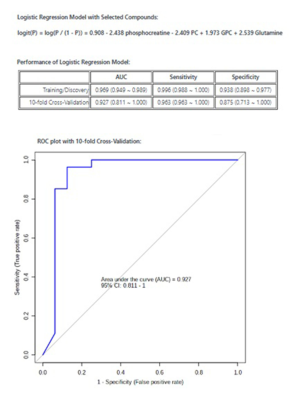 |
171 |
Predictive diagnosis of Major Depressive Disorder using
integrated NMR based metabolomics and logistic regression model
approach
Ritu Tyagi1,
Vishwa Rawat1,
Gagan Hans2,
Pratap sharan2,
S Senthil Kumaran1,
and Uma Sharma1
1Department of NMR, All India Institute of Medical Sciences (AIIMS), New Delhi, India, 2Department of Psychiatry, All India Institute of Medical Sciences (AIIMS), New Delhi, India Keywords: Psychiatric Disorders, Spectroscopy, NMR based metabolomics, Logistic regression analysis, blood serum, neuroinflammation The current diagnosis for Major Depressive disorder (MDD) is dependent on symptomatic clusters and resulting high error rates. The study identifies a panel of biomarkers using 1H NMR spectroscopy and logistic regression prediction modelling. The VIP score of >1.5 and S-plot based on OPLS-DA depicted 4 significant metabolites (phosphocreatine, phosphocholine, glycerophosphocholine and glutamine) indicating abnormalities in energy and lipid metabolism. Phosphocreatine showed the highest AUC of 0.875 with 90% sensitivity and specificity, while with a combination of 4 metabolites, the AUC increased to 0.927 with 96.3% sensitivity and 87.5% specificity, which may act as a supplementary diagnostic tool for MDD. |
|
4938.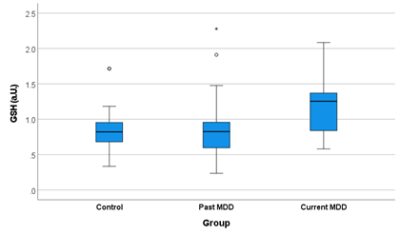 |
172 |
Prefrontal glutathione levels in major depressive disorder are
linked to a loss of positive mood
Ruth O'Gorman Tuura1,
Andreas Buchmann2,3,
Christopher Ritter2,3,
Melanie Haynes4,
Ralph Noeske5,
and Gregor Hasler3
1University Children's Hospital Zurich, Zurich, Switzerland, 2Center for MR Research, University Children's Hospital Zurich, Zurich, Switzerland, 3Psychiatry Research Unit, University of Fribourg, Fribourg, Switzerland, 4Translational Research Center, University Hospital of Psychiatry and Psychotherapy, Bern, Switzerland, 5GE Healthcare, Munich, Germany Keywords: Psychiatric Disorders, Spectroscopy Major depressive disorder (MDD) is one of the most common neuropsychiatric disorders, with symptoms including persistent sadness and low mood. MDD is associated with neurochemical alterations in GABA, glutamate, and glutamine levels, but to date few studies have examined changes in glutathione (GSH) in MDD. This study investigated changes in GSH in a medication naïve group of participants with current and past depression, and healthy controls, and the link between GSH, stress markers, depressive symptoms and mood. We observed elevated prefrontal GSH in participants with current but not remitted depression, which was associated with a decrease in positive mood. |
|
4939.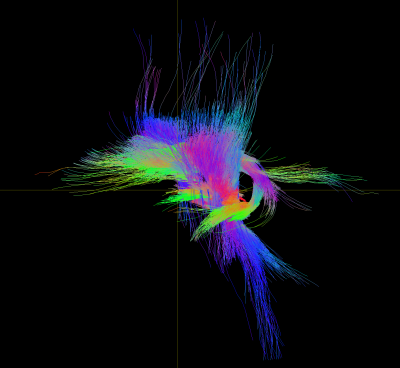 |
173 |
Altered Structural Connectivity Of Thalamocortical Connections
in Major Depressive Disorder: A 7T Study
Ameen S. Al Qadi1,
Gaurav S. Verma1,
James S. Murrough2,
and Priti S. Balchandani 1
1Biomedical Engineering And Imaging Institute, Icahn School Of Medicine At Mount Sinai, New York, NY, United States, 2Department Of Psychiatry, Icahn School Of Medicine At Mount Sinai, New York, NY, United States Keywords: Psychiatric Disorders, Brain Connectivity, Tractography, 7T, Major Depressive Disorder This study investigated the structural integrity of thalamic nuclei and their white matter connections in the brains of patients with Major Depressive Disorder (MDD) to help elucidate MDD etiology using diffusion tractography and structural MRI at 7T. Group differences were found with decreased FA and increased MD, RD, and AD in the tracts of multiple nuclei in the MDD cohort compared to controls. There were no significant differences in the average volumes of the nuclei between groups. These results suggest aberrant axonal integrity in multiple pathways responsible for visual & auditory processing, motor function, and emotional response networks. |
|
4940.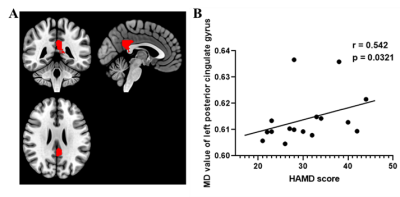 |
174 |
Free water DTI for evaluating gray matter microstructure in
major depressive disorder: A preliminary study
Xuecong Lin1,
Junyan Wen1,
Shanshan Yang1,
Wei Cui2,
Long Qian2,
Yanyu Hao1,
Liya Gong1,
Weikang Huang3,
Haijie Zhang4,
and Ge Wen1
1Medical Imaging Department, Nanfang Hospital, Guangzhou, China, 2MR Research, GE Healthcare, Beijing, China, Beijing, China, 3Department of Radiology, Zengcheng Branch of Nanfang Hospital, Guangzhou, China, 4PET/CT Center, Department of Nuclear Medicine, First Affiliated Hospital of Shenzhen University, Shenzhen Second People’s Hospital, Shenzhen, China Keywords: Psychiatric Disorders, Brain, Major depressive disorder Major depressive disorder (MDD) is a common mental disease with unclear pathophysiology. Herein, we explored the differences in the whole-brain gray matter free-water axial diffusivity (AD) and mean diffusivity (MD) values between MDD patients and healthy controls using free-water DTI. The results showed altered free-water AD and MD values in specific regions of the gray matter in MDD patients, which may be associated with alterations in the brain gray matter microstructure, such as microstructure damage or neurodegeneration. Thus, these quantitative variables could be used as valuable biomarkers that could further our understanding of the pathophysiological mechanisms of depression. |
|
4941.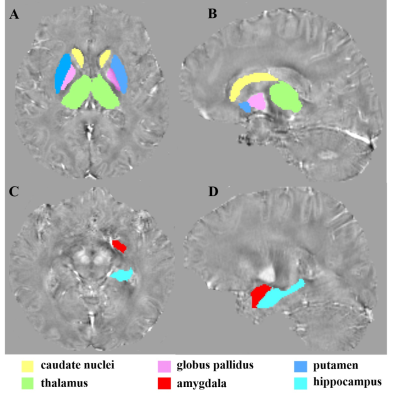 |
175 |
Quantitative Study of Brain Iron Deposition in Major Depression
Disorder
Bo Zhou1,
Wenjia Liang2,
Chenxi Sun2,
Wenjun Wang2,
Weiqiang Dou3,
Dmytro Pylypenko3,
Huimin Hou4,
and Bao Wang1
1Department of Radiology, Qilu Hospital of Shandong University, Jinan, China, 2Department of Anatomy and Neurobiology, Cheeloo College of Medicine, Shandong University, Jinan, China, 3MR Research China, GE Healthcare, Beijing, China, 4Department of Orthopedic Surgery, Qilu Hospital of Shandong University, Jinan, China Keywords: Psychiatric Disorders, Quantitative Susceptibility mapping The occurrence of depression may be related to the accumulation of iron in the brain. T1-weighted images were linearly registered into the QSM space, and then six regions of interest (ROIs) were obtained using the automated segmentation pipeline. Susceptibility values of major depression disorder (MDD) and healthy control (HC) groups were compared using the two-sided Student's t-test. The susceptibility of the left amygdala and right putamen in MDD patients were significantly increased, and positively correlated with the severity of depression and insomnia, respectively. The increased iron in the left amygdala may be a new biomarker for MDD. |
|
4942. |
176 |
White matter alterations in patients with major depressive
disorder: A Quantitative synthetic MRI Study
Junyan Wen1,
Shanshan Yang1,
Xuecong Lin1,
Wei Cui2,
Long Qian2,
Zhimin Chen1,
Liaoming Gao1,
Qian Gao3,
Weikang Huang 4,
Dongliang Cheng5,
and Ge Wen1
1Medical Imaging Department, Nanfang Hospital, Guangzhou, China, 2MR Research, GE Healthcare, Beijing, China, Beijing, China, 3Department of Radiology, the First Affiliated Hospital of Kunming Medical University, Kunming, China, 4Department of Radiology, Zengcheng Branch of Nanfang Hospital, Guangzhou, China, 5Department of Radiology, First People's Hospital of Foshan, Foshan, China Keywords: Psychiatric Disorders, Brain, Major depressive disorder; white matter microstructure Major depressive disorder (MDD) is a severe mental disorder with unclear pathophysiology mechanism. The present study aimed explore white matter (WM) microstructure alterations in MDD patients using synthetic MRI technique. The results showed shorter T1 relaxation time in several deep WM regions, while extensive myeline content was found in left anterior limb of internal capsule in patients with MDD. Thus, we concluded that WM alterations caused by MDD can be revealed by quantitative MRI parameters. |
|
4943.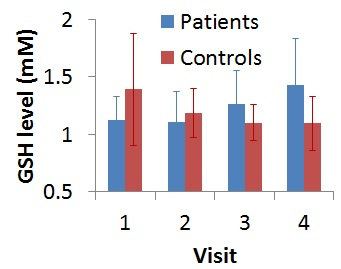 |
177 |
Modulation of left anterior cingulate glutathione in Lithium
treatment of bipolar disorder
Pallab Bhattacharyya1,
Bo Hu1,
Mark Lowe1,
and Amit Anand2
1Cleveland Clinic Foundation, CLEVELAND, OH, United States, 2Brigham and Women's Hospital, Boston, MA, United States Keywords: Psychiatric Disorders, Spectroscopy Changes in total glutathione (GSH) level in left anterior cingulate cortex (ACC) following lithium monotherapy of bipolar disorder in depressed state were studied at7T. Patients were scanned with a semi-LASER sequence at baseline and 2, 8 and 26 weeks from onset of therapy. Healthy controls were also scanned at those 4 time points. An increase in GSH level at left dorsal/rostral ACC was observed in patients, and the increase took place between 8 and 26 weeks after the start of therapy. |
|
4944.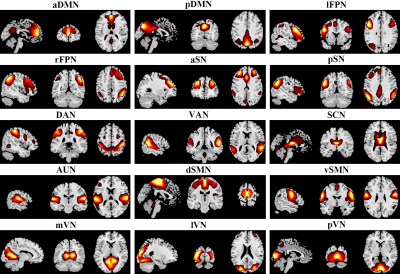 |
178 |
Resting-state brain functional connectome disruptions in social
anxiety disorder
Xun Zhang1 and
Qiyong Gong1
1Department of Radiology, Huaxi MR Research Center (HMRRC), West China Hospital of Sichuan University, Chengdu, China Keywords: Psychiatric Disorders, fMRI (resting state), gray matter Social anxiety disorder (SAD) is a prevalent disabling psychiatric condition, for which the underlying neurobiological mechanisms remain poorly understood. Herein, we used group independent component analysis to characterize the functional architecture of brain resting-state networks (RSNs) and investigate between-group differences in intra- and inter-network functional network connectivity (FNC), as well as their associations with clinical characteristics and their potential diagnostic value. As a result, we observed widespread intra-/inter-network FNC abnormalities among high-order and primary perceptual RSNs in SAD, which were correlated to the symptom severity and illness duration, and allowed individual classification of SAD versus healthy controls with significant accuracy. |
|
4945.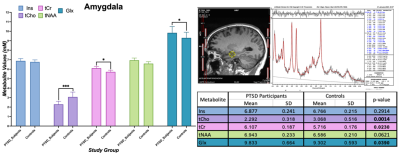 |
179 |
Assessment of Oxidative Stress and Neuronal Activity Affected in
PTSD Subjects
Antonia Susnjar1,
Gianna Nossa2,
Joseph V Rispoli1,
Ulrike Dydak2,3,
and Meden Issac-Lam4
1Weldon School of Biomedical Engineering, Purdue University, West Lafayette, IN, United States, 2School of Health Sciences, Purdue University, West Lafayette, IN, United States, 3Department of Radiology and Imaging Sciences, Indiana School of Medicine, Indianapolis, IN, United States, 4Department of Chemistry and Physics, Purdue Northwest University, Hammond, IN, United States Keywords: Psychiatric Disorders, Trauma, PTSD We are reporting neurometabolic imbalances in post-traumatic stress disorder using edited and unedited single voxel spectroscopy with optimized HERMES data acquisition at 3T. We have investigated five brain regions that play a significant role in PTSD including insula, hippocampus, amygdala, anterior, and dorsolateral prefrontal cortex. Our findings report the largest metabolic concentration changes in amygdala which moderates flight or fight state. Moreover, we observe decrease of primary neurotransmitter GABA in hippocampus, antioxidant GSH in DLPFC, and membrane turnover marker tCho across all brain regions. |
|
4946. |
180 |
Neurochemical effects of intrusive thinking in pathological and
non-pathological worriers: A combined MRS, functional
connectivity study
Antonio Napolitano1,
Martino Schettino2,3,
Chiara Parrillo1,
Giulia Baldassari1,
Luca Cairone1,
Salvatore Gazzellini1,
Federico Giove3,4,
and Cristina Ottaviani2,3
1Bambino Gesù Pediatric Hospital, Rome, Italy, 2Sapienza University of Rome, Rome, Italy, 3IRCCS Santa Lucia Foundation, Rome, Italy, 4Centro Ricerche Enrico Fermi, Rome, Italy Keywords: Psychiatric Disorders, Brain, Spectroscopy; GABA; Glx The present study combined magnetic resonance spectroscopy, resting state functional connectivity and ecological momentary assessment to support the view that intrusive thinking may be pathologically maintained via negative reinforcement, namely a reduction in autonomic arousal that prevents the transition from a relaxed state to a spike of activation. |
|
The International Society for Magnetic Resonance in Medicine is accredited by the Accreditation Council for Continuing Medical Education to provide continuing medical education for physicians.